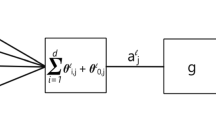
Access this book
Tax calculation will be finalised at checkout
Other ways to access
About this book
Two research communities which have used graphical or network formalisms to particular advantage are the belief network community and the neural network community. Belief networks arose within computer science and statistics and were developed with an emphasis on prior knowledge and exact probabilistic calculations. Neural networks arose within electrical engineering, physics and neuroscience and have emphasised pattern recognition and systems modelling problems. This volume draws together researchers from these two communities and presents both kinds of networks as instances of a general unified graphical formalism. The book focuses on probabilistic methods for learning and inference in graphical models, algorithm analysis and design, theory and applications. Exact methods, sampling methods and variational methods are discussed in detail.
Audience: A wide cross-section of computationally oriented researchers, including computer scientists, statisticians, electrical engineers, physicists and neuroscientists.
Similar content being viewed by others
Keywords
Table of contents (23 chapters)
-
Front Matter
-
Inference
-
Front Matter
-
-
Foundations for Learning
-
Front Matter
-
Editors and Affiliations
Bibliographic Information
Book Title: Learning in Graphical Models
Editors: Michael I. Jordan
Series Title: NATO Science Series D:
DOI: https://doi.org/10.1007/978-94-011-5014-9
Publisher: Springer Dordrecht
-
eBook Packages: Springer Book Archive
Copyright Information: Springer Science+Business Media Dordrecht 1998
Hardcover ISBN: 978-0-7923-5017-0Published: 31 March 1998
Softcover ISBN: 978-94-010-6104-9Published: 29 October 2012
eBook ISBN: 978-94-011-5014-9Published: 06 December 2012
Series ISSN: 0258-123X
Edition Number: 1
Number of Pages: XI, 630
Topics: Artificial Intelligence, Complex Systems, Statistics, general, Statistical Physics and Dynamical Systems



